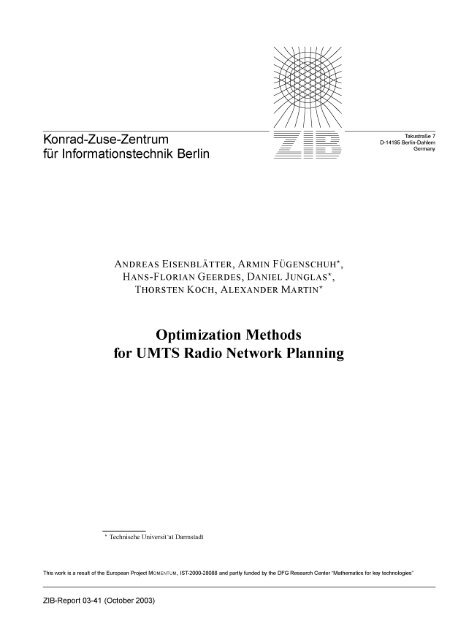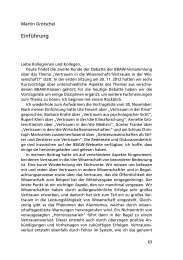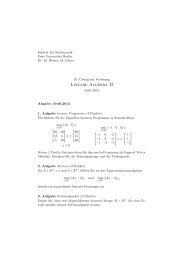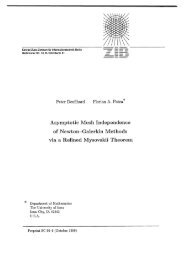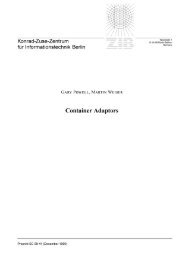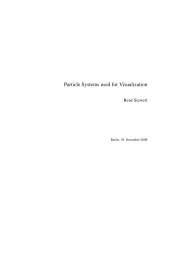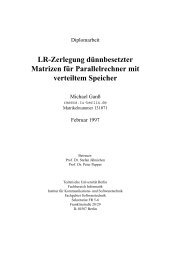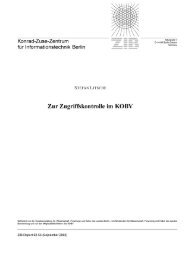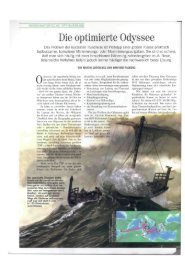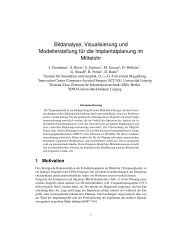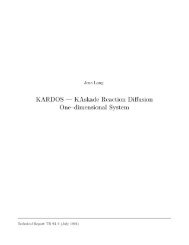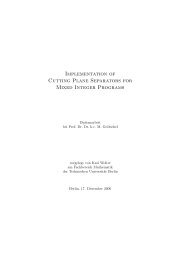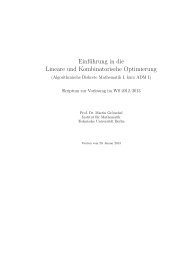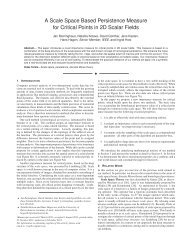Optimization Methods for UMTS Radio Network Planning - ZIB
Optimization Methods for UMTS Radio Network Planning - ZIB
Optimization Methods for UMTS Radio Network Planning - ZIB
Create successful ePaper yourself
Turn your PDF publications into a flip-book with our unique Google optimized e-Paper software.
Konrad-Zuse-Zentrum<br />
fu¨r In<strong>for</strong>mationstechnik Berlin<br />
Takustraße 7<br />
D-14195 Berlin-Dahlem<br />
Germany<br />
A NDREAS E ISENBLATTER , A RMIN F UGENSCHUH*,<br />
HANS-FLORIAN GEERDES, DANIEL JUNGLAS ,<br />
THORSTEN KOCH, ALEXANDER MARTIN<br />
<strong>Optimization</strong> <strong>Methods</strong><br />
<strong>for</strong> <strong>UMTS</strong> <strong>Radio</strong> <strong>Network</strong> <strong>Planning</strong><br />
Technische Uni<br />
Universit¨at Darmstadt<br />
This work is a result of the European Project MOMENTUM, IST-2000-28088 and partly funded by the DFG Research Center “Mathematics <strong>for</strong> key technologies”<br />
<strong>ZIB</strong>-Report 03-41 (October 2003)
<strong>Optimization</strong> <strong>Methods</strong><br />
<strong>for</strong> <strong>UMTS</strong> <strong>Radio</strong> <strong>Network</strong> <strong>Planning</strong>***<br />
AndreasEisenbl¨atter, ArminF ¨ugenschuh 2 , Hans-FlorianGeerdes 3 , Daniel<br />
Junglas 2 , Thorsten Koch 3 , and Alexander Martin 2<br />
1 Atesio GmbH, Berlin<br />
2<br />
Technische Universit¨at Darmstadt<br />
3<br />
Konrad-Zuse-Zentrum f¨ur In<strong>for</strong>mationstechnik Berlin (<strong>ZIB</strong>)<br />
Abstract. The <strong>UMTS</strong> radio network planning problem poses the challenge of designing a<br />
cost-effective network that provides users with sufficient coverage and capacity. We describe<br />
an optimization model <strong>for</strong> this problem that is based on comprehensive planning data of the<br />
EU project MOMENTUM. We present heuristic mathematical methods <strong>for</strong> this realistic model,<br />
including computational results.<br />
1 Introduction<br />
Third generation (3G) telecommunication networks based on <strong>UMTS</strong> technology<br />
are currently being deployed across Europe. <strong>Network</strong> operators face planning challenges,<br />
<strong>for</strong> which experiences from 2G GSM barely carry over. The EU-funded<br />
project MOMENTUM developed models and simulation methods <strong>for</strong> <strong>UMTS</strong> radio<br />
network design. Among others, we devised network optimization methods that are<br />
based on a very detailed mathematical model.<br />
MOMENTUM constitutes, of course, not the only ef<strong>for</strong>t to advance methods <strong>for</strong><br />
<strong>UMTS</strong> radio network planning. In [1,2,3] several optimization models are suggested<br />
and heuristics methods such as tabu search or greedy are used to solve them. Integer<br />
programming methods <strong>for</strong> planning are shown in [12], power control and capacity<br />
issues are treated in [4,11]. Many technical aspects of <strong>UMTS</strong> networks and some<br />
practice-driven optimization and tuning rules are given in [ 10]. <strong>Optimization</strong> of certain<br />
network aspects without site selection is treated in [9].<br />
Within this article, we focus on heuristic algorithms to solve the optimization<br />
task. <strong>Methods</strong> based directly on the mathematical mixed integer programming model<br />
presented in [5,8] will be presented in the future. The preliminary computational results<br />
obtained within MOMENTUM are very promising.<br />
2 <strong>Optimization</strong> Approach<br />
Our optimization approach is snapshot based. A snapshot is a set of users that want<br />
to use the network at the same time. We consider several snapshots at once and try<br />
* This work is a result of the European Project MOMENTUM, IST-2000-28088<br />
** Partly funded by the DFG Research Center “Mathematics <strong>for</strong> key technologies”
2 Andreas Eisenbl¨atter et al.<br />
to find a network that per<strong>for</strong>ms well <strong>for</strong> these snapshots and is cost-effective at the<br />
same time. Snapshots are typically drawn according to service-specific spatial traffic<br />
load distributions.<br />
2.1 <strong>Optimization</strong> Model<br />
The following decisions have to be made <strong>for</strong> planning a network:<br />
Site Selection. From a set S of potential sites (roughly equivalent to roof tops<br />
where antenna masts could be placed), a subset of sites to be opened has to<br />
be chosen.<br />
Installation Selection. At each opened site various installations (antenna configurations)<br />
can be employed at different antenna locations. From the set I of all<br />
possible installations a subset has to be selected. The number of antennas per<br />
site is limited; three-sectorized sites are typical.<br />
Mobile Assignment. For each of the users, represented by the set M of mobiles<br />
that is possibly distributed over several snapshots, we have to decide which<br />
installation serves which mobile device. This is in practice often done on a bestserver<br />
basis: each mobile is served by the installation whose signal is strongest<br />
at the mobile’s location.<br />
Power Assignment. Once the users are attached to installations, a feasible combination<br />
of power values has to be found. This includes transmission powers in<br />
uplink and downlink as well as the cells’ pilot powers.<br />
This is <strong>for</strong>mulated as a MIP in [5,8], with binary variables corresponding to the first<br />
three decisions and fractional power variables p.<br />
The coverage and capacity requirements are reflected in so-called CIR inequalities<br />
(Carrier-to-Interference-Ratio) that have to hold <strong>for</strong> each user. These inequalities<br />
at the core of our optimization model follow the pattern:<br />
Received Signal<br />
— : —— :— ≥ Threshold<br />
Interfering Signals + Noise<br />
Using the notation from Table 1, the CIR inequality <strong>for</strong> the uplink reads:<br />
m<br />
T<br />
—f mr——F—v ≥ ßl (1a)<br />
pj-l m ja m p P m m<br />
The CIR inequality <strong>for</strong> the downlink is somewhat more complicated, since code<br />
orthogonality has to be considered <strong>for</strong> signals from the same cell:<br />
7 \-7<br />
3TO p"! ≥ ß m (1b)<br />
7j m M - cc m J (pjj - a m p l jm\ + J2i^j i im p i + Vm
<strong>UMTS</strong> <strong>Radio</strong> <strong>Network</strong> <strong>Planning</strong> 3<br />
ηm > 0 noise at mobile m<br />
αm,αm G [0, 1] uplink/downlink activity factor of mobile m<br />
ωm G [0, 1] orthogonality factor <strong>for</strong> mobile m<br />
µm, µm >0 uplink/downlink CIR target <strong>for</strong> mobile m<br />
γ j, γjm ^ [0, 1] attenuation factors between mobile m and installation j<br />
pm G R+ uplink transmit power from mobile m<br />
p l G R+ downlink transmit power from installation i to mobile m<br />
im G R+ Total received uplink power at installation j (in the snapshot)<br />
G R+ Total downlink power emitted by installation j (in the snapshot)<br />
Table 1. Notations in CIR inequalities<br />
2.2 <strong>Planning</strong> Data<br />
Input data <strong>for</strong> our optimization model is derived from the planning scenarios developed<br />
within the EU project MOMENTUM. The full contents of these scenarios are<br />
described in [7], several scenarios of them are publicly available at [13]. The scenarios<br />
contain detailed data on aspects relevant to <strong>UMTS</strong> radio network planning.<br />
The data can be classified as follows:<br />
<strong>Radio</strong> and Environment. All aspects of the “outside” world. This includes radio<br />
propagation, <strong>UMTS</strong> radio bearers, in<strong>for</strong>mation on the terrain (such as height or<br />
clutter data), and background noise.<br />
Infrastructure. All aspects that are to some extent under the control of the network<br />
operator. This includes base station hardware, antennas, potential sites and antenna<br />
locations, and radio resource management.<br />
User Demand. All aspects related to users, such as offered services (e. g., video<br />
telephony, media streaming), user mobility, usage specifics, and traffic data.<br />
The potential sites and installations <strong>for</strong> the planning scenario “The Hague” are<br />
shown in Fig. 1(a), the average user demand is illustrated in Fig. 1(b). Darker areas<br />
indicate higher traffic load here, the users in the snapshots are generated according<br />
to this distribution together with additional in<strong>for</strong>mation on the used services, equipment,<br />
and mobility. The actual parameters <strong>for</strong> the optimization model [8] and the<br />
CIR inequalities (1), in particular, are derived from the in<strong>for</strong>mation in the planning<br />
scenarios. Table 2 gives an overview.<br />
2.3 Preprocessing: Coverage and Capacity Analysis<br />
Be<strong>for</strong>e an automatic planning process can be employed, the input data is analyzed<br />
in order to detect coverage and capacity shortages. The coverage-oriented analysis<br />
is based on propagation path loss predictions <strong>for</strong> all available sites and their antenna<br />
locations. Capacity shortages are harder to detect. We use a heuristic, which is based<br />
on a tentative network design using all available sites. Employing methods similar<br />
to the ones described in [4,14], the average up- and downlink load per cell of this<br />
tentative network can be computed efficiently. If the traffic load is too high <strong>for</strong> the
4<br />
Andreas Eisenbl atter et al.<br />
(a) Potential sites and antenna<br />
configurations (installations)<br />
(b) Traffic distribution<br />
Fig. 1. Example of planning scenario (The Hague)<br />
<strong>Planning</strong> Scenario<br />
Equipment loss, Connection loss<br />
Propagation loss, Antenna gain<br />
Usage loss (e. g. body)<br />
BLER requirements<br />
User speed<br />
<strong>Radio</strong> bearer<br />
User equipment, User mobility<br />
<strong>Radio</strong> bearer<br />
Clutter type<br />
Channel model<br />
Parameter<br />
Signal attenuation γ m j ,γ j m<br />
CIR targets l^vn,l^vn<br />
Activity factors<br />
T a 1<br />
Orthogonality ω m<br />
Table 2. Derivation of parameters from the data scenarios<br />
potential infrastructure in some regions, these can be localized as overloaded cells<br />
in the tentative network. Notice that this approach merely provides lower bounds on<br />
the achievable network up- and downlink capacity. <strong>Methods</strong> <strong>for</strong> estimating an upper<br />
bound on the network capacity are under development.<br />
3 Heuristic <strong>Planning</strong> <strong>Methods</strong><br />
It turned out that solving mixed-integer program as described in its main components<br />
in Section 2.1 exactly (using <strong>for</strong> example CPLEX 8.1) takes significant time<br />
and computing resources, even <strong>for</strong> moderate sized scenarios.<br />
There<strong>for</strong>e, we developed various heuristic algorithms that aim at obtaining good<br />
(not necessarily optimal) solutions within reasonable running times. The explanation<br />
of all these methods, including greedy-type heuristics, tabu search, simulated<br />
annealing, and evolution algorithms, is beyond the scope of this document. We re-
<strong>UMTS</strong> <strong>Radio</strong> <strong>Network</strong> <strong>Planning</strong> 5<br />
strict ourselves to the most successful one, the “Set-Covering Heuristic”. The interested<br />
reader may refer to [5,6] <strong>for</strong> the description of the other methods.<br />
3.1 Set-Covering Heuristic<br />
The idea of the Set-Covering Heuristic is to find <strong>for</strong> each installation i
6 Andreas Eisenbl¨atter et al.<br />
1. Determine the mobile/installation distance d m,i <strong>for</strong> each mobile in M.<br />
2. Sort M by non-decreasing distance to i. Denote result by M sorte d.<br />
3. Set M return = ∅ and c return = Ci.<br />
4. For each mobile m ∈ M sorte d do<br />
(a) Set M' = M return ∪ {m}.<br />
(b) Use Power Assignment Heuristic to check whether installation i can serve<br />
all mobiles in M'.<br />
(c) If so, set M retu rn = M' and update c return according to equation (2).<br />
5. Return M return and c return .<br />
Given the sets Mi and associated costs c i <strong>for</strong> each installation, we define a setcovering<br />
problem. Let A ∈ R M I x l x l denote the incidence matrix of M and the<br />
Mi (i. e., aij = 1 if and only if mobile i is in Mj) and introduce binary variables<br />
xj,j = 1,...,|I| that are set to one if set Mj is selected and to zero otherwise. The<br />
set-covering problem then reads as follows:<br />
mini J2cixi | Ax≥1,x∈{0,1}W\ (3)<br />
iei<br />
Notice that in the above description we implicitly assume that Uiei M = M . If<br />
this is not the case we simply replace M by (JigI M.<br />
As stated earlier, each set Mi is in direct correspondence with an installation<br />
i ∈ I. Thus, given an optimal solution x ∈ {0,1}' ' to (3) we simply select all<br />
installations i∈I <strong>for</strong> which xi = 1 and install them.<br />
The Set-Covering algorithm as described above has three problems:<br />
• Model (3) is too simplistic: it does, <strong>for</strong> example, not take into account that installations<br />
are hosted at sites. Opening such a site requires a certain amount of<br />
money (typically much more than the cost <strong>for</strong> a single antenna) and <strong>for</strong> each<br />
site there are minimum and maximum numbers of installations that can be simultaneously<br />
installed.<br />
• Due to the fact that we ignore all other installation while computing the set Mi<br />
<strong>for</strong> installation i, we also ignore potential interference from these installations.<br />
The sets Mi tend to overestimate the coverage and capacity of the installations.<br />
• The set-covering problem as defined in (3) may not have a feasible solution.<br />
This can especially happen if traffic is high and the number of installations that<br />
are available per site is limited.<br />
All three problems can be resolved: In the first case, the additional constraints<br />
related to sites can easily be added to (3). In the second case, we shrink the sets<br />
Mi at the end of Algorithm 1 using a “shrinkage factor” fshrink. Or we impose some<br />
heuristically determined interference via a “load factor” f load and require that the<br />
installation may not use more than that percentage of its maximum load during the<br />
algorithm. We distinguish two cases if (3) is infeasible. Incase fshrink and fload equal<br />
one we declare the input infeasible (which is true up to the assumption that we have<br />
per<strong>for</strong>med an optimal mobile assignment). In case at least one of these factors is<br />
less than one we modify the factors and iterate.
<strong>UMTS</strong> <strong>Radio</strong> <strong>Network</strong> <strong>Planning</strong> 7<br />
3.2 Results<br />
Using the Set-Covering Heuristic we are able to compute good solutions to largescale<br />
real world instances. We illustrate one such result <strong>for</strong> the “The Hague” scenario<br />
mentioned in Section 2. The instance contains 76 potential sites, 912 potential<br />
installations, and 10,800 mobiles partitioned into 20 snapshots (approximately 540<br />
mobiles per snapshot). For this instance we obtained the best result using a combination<br />
of the “heuristic interference” and “heuristic shrinking” strategies by setting<br />
f shrink = 0.7 and f load = 0.6.<br />
With these modifications the Set-Covering heuristic took 66 minutes on a 1GHz<br />
INTEL PENTIUM-III processor with 2GB RAM to find the finalinstallation selection.<br />
Fig. 2 depicts the solution. Fig. 2(a) shows the selected installations/antennas;<br />
the load in the network is illustrated <strong>for</strong> uplink and downlink in Fig. 2(b) and<br />
Fig. 2(c) (the light areas denote a load of about 25–30%, the darker areas have less<br />
load). Our result was evaluated using advanced static network simulation methods<br />
developed within the MOMENTUM project [14]. The methods reported at most 3%<br />
missed traffic.<br />
(a) Selected antennas (b) Uplink load (c) Downlink load<br />
Fig. 2. Heuristic planning solution<br />
4 Conclusion<br />
We presented an optimization problem of planning cost-effective <strong>UMTS</strong> radio networks.<br />
The model we use reflects many aspects of reality that are essential <strong>for</strong> planning<br />
<strong>UMTS</strong> networks. To our knowledge, this is the most detailed and comprehensive<br />
planning model in literature. Based on this model, we have described some<br />
heuristic network planning methods that work well in practice and lead to good<br />
results.
8 Andreas Eisenbl¨atter et al.<br />
References<br />
1. E. Amaldi, A. Capone, and F. Malucelli. <strong>Planning</strong> <strong>UMTS</strong> base station location: <strong>Optimization</strong><br />
models with power control and algorithms. IEEE Transactions on Wireless<br />
Communications, 2002.<br />
2. E. Amaldi, A. Capone, F. Malucelli, and F. Signori. <strong>UMTS</strong> radio planning: Optimizing<br />
base station configuration. In Proceedings of IEEE VTC Fall 2002, volume 2, pages<br />
768–772, 2002.<br />
3. E. Amaldi, A. Capone, F. Malucelli, and F. Signori. Optimizing base station location and<br />
configuration in <strong>UMTS</strong> networks. In Proceedings of INOC 2003, pages 13–18, 2003.<br />
4. D. Catrein, L. Imhof, and R. Mathar. Power control, capacity, and duality of up- and<br />
downlink in cellular CDMA systems. Technical report, RWTH Aachen, 2003.<br />
5. A. Eisenbl¨atter, E. R. Fledderus, A. F¨ugenschuh, H.-F. Geerdes, B. Heideck, D. Junglas,<br />
T. Koch, T. K¨urner, and A. Martin. Mathematical methods <strong>for</strong> automatic optimisation<br />
of <strong>UMTS</strong> radio networks. Technical Report IST-2000-28088-MOMENTUM-D43-INT,<br />
IST-2000-28088 MOMENTUM, 2003.<br />
6. A. Eisenbl¨atter, H.-F. Geerdes, D. Junglas, T. Koch, T. K¨urner, and A. Martin. Final<br />
report on automatic planning and optimisation. Technical Report IST-2000-28088-<br />
MOMENTUM-D47-PUB, IST-2000-28088 MOMENTUM, 2003.<br />
7. A. Eisenbl¨atter, H.-F. Geerdes, T. Koch, and U. T¨urke. MOMENTUM public planning<br />
scenarios and their XML <strong>for</strong>mat. Technical Report TD(03) 167, COST 273, Prague,<br />
Czech Republic, 2003.<br />
8. A. Eisenbl¨atter, T. Koch, A. Martin, T. Achterberg, A. F¨ugenschuh, A. Koster, O. Wegel,<br />
and R. Wess¨aly. Modelling feasible network configurations <strong>for</strong> <strong>UMTS</strong>. In G. Anandalingam<br />
and S. Raghavan, editors, Telecommunications <strong>Network</strong> Design and Management.<br />
Kluwer, 2002.<br />
9. A. Gerdenitsch, S. Jakl, M. Toeltsch, and T. Neubauer. Intelligent algorithms <strong>for</strong> system<br />
capacity optimization of <strong>UMTS</strong> FDD networks. In Proc. IEEE 4th International<br />
Conference on 3G Mobile Communication Technology, pages 222–226, London, 2002.<br />
10. J. Laiho, A. Wacker, and T. Novosad, editors. <strong>Radio</strong> <strong>Network</strong> <strong>Planning</strong> and <strong>Optimization</strong><br />
<strong>for</strong> <strong>UMTS</strong>. John Wiley & Sons Ltd., 2001.<br />
11. K. Leibnitz. Analytical Modeling of Power Control and its Impact on Wideband CDMA<br />
Capacity and <strong>Planning</strong>. PhD thesis, University of W¨urzburg, 2003.<br />
12. R. Mathar and M. Schmeink. Optimal base station positioning and channel assignment<br />
<strong>for</strong> 3G mobile networks by integer programming. Ann. of Operations Research,<br />
(107):225–236, 2001.<br />
13. MOMENTUM Project. Models and simulations <strong>for</strong> network planning and control of<br />
<strong>UMTS</strong>. http://momentum.zib.de, 2001. IST-2000-28088 MOMENTUM.<br />
14. U. T¨urke, R. Perera, E. Lamers, T. Winter, and C. G¨org. An advanced approach <strong>for</strong> QoS<br />
analysis in <strong>UMTS</strong> radio network planning. In Proc. of the 18th International Teletraffic<br />
Congress, pages 91–100. VDE, 2003.


